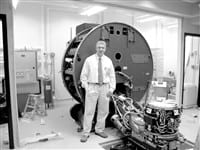Homing In Technological Advances Sharpen Effectiveness Of Prostate Cancer Treatments
As cancer treatments have become more powerful and effective over the years, they have also posed a double-edged sword.
In the case of radiation therapy for prostate cancer, the question has been, how strongly can a doctor target cancerous cells without causing damage to the healthy tissue nearby?
That question has been addressed in significant ways over the past few years, and Springfield is reaping the benefits. Both the D’Amour Center for Cancer Care and the soon-to-open Sr. Caritas Cancer Center — divisions of Baystate Health System and Mercy Medical Center, respectively — are incorporating high-tech, high-price advances that allow doctors to better hone their cancer treatments than ever before.
The technology at issue is called intensity modulated radiation therapy, or IMRT, and it’s administered now on four linear accelerators at Baystate’s cancer center, and will be starting this fall on two such accelerators at Mercy.
“That’s the most important development over the past five years, and something we’re just in the process of introducing,” said Dr. Brian Acker, division chief of Radiation Oncology in the Baystate Regional Cancer Program.
“IMRT allows us to more precisely focus the radiation beam and tailor the radiation delivery to conform more closely to the shape of the prostate gland, and deliver less of a dose to adjacent, normal organs, primarily the bladder and rectum. By doing so, we can decrease the side effects and long-term toxicity of radiation therapy.”
Stronger Medicine
Of course, Acker added, part of the reason the ability to more tightly target the dosage is so exciting is that it’s coupled with the ability to safety escalate the dose.
That could make a huge difference in fighting the most common form of cancer for men, a scourge that affects 2.8 million Americans and kills some 32,000 men each year.
“One of the key elements of what IMRT has to offer is the potential for a higher rate of control and rate of cure,” Acker said.
While traditional external beam radiation therapy utilized one large radiation beam, IMRT effectively breaks down a series of beams into scores of what Acker called “beamlets,” which are then focused on a pre-determined area around cancer.
“You can actually produce within the patient almost any arbitrary shape of dose distribution,” he added. “It’s known as ‘dose painting.’ No one could do this by hand, so they had to develop new computer programs specifically to determine what combination of beamlets will produce the required dose and distribution. It’s an entirely new paradigm of treatment.”
Timothy Klapproth, senior medical dosimetrist at Mercy Medical Center, used the same kind of painting analogy when describing the way IMRT works.
“Every part of the patient’s anatomy inside the scan is assigned a certain level of dosage to it,” he said, “so if a tumor is localized in one small area of the prostate, IMRT enables us to accurately pinpoint the maximum radiation right in that area, but allows us to assign other values to normal structures we want to make sure do not receive harmful doses. IMRT can actually shape the dose as if it’s painting it with a paintbrush.”
This technology is accompanied at Mercy by equipment dubbed the iView, which allows technicians to make adjustments for subtle movements of the prostate from day to day.
“The prostate is encompassed by the bladder and rectum, and the volume of these organs at any given time influences where the prostate lies, literally on an hour-to-hour basis” Klapproth said.
“Treatment averages 41 days, so you have 41 days of possible position change of the organ. But we can now deliver, based on these advanced protocols, radiation to the prostate with the greatest sense of surety and confidence, and that truly is a landmark opportunity for all patients.”
Baystate tackles the ‘moving prostate’ problem with a system called Acculoc, which incorporates the insertion of three gold seed markers into the organ, which may then be read by the electronic imaging system.
“We can determine whether a shift needs to be made to compensate for a change in the prostate’s position,” Acker said. “Moves up to a centimeter can be made during treatment, so we’re able to confidently use tight margins and treat less of the normal organs adjacent to the prostate.”
Seeds of Change
That procedure carries some shades of brachytherapy, or seed therapy, which not too long ago was the hottest advance in prostate cancer treatment. In that process, between 70 and 130 tiny radioactive pellets of Iodine-125 are inserted into the prostate.
“That type of therapy is reaching a level of maturation,” Klapproth said. “The techniques are well-proven, and the efficacy of the seed implantation is now equal to that of a prostotectomy or the external beam radiotherapy, so the patient today who seeks prostate cancer treatment really has a wide choice of options.”
But because of the way IMRT has sharpened the focus of external beam radiotherapy, that treatment method is the one that holds the most promise and excitement at the moment, he said.
The downside, Acker said, is that the new processes are very complex and time-intensive, not to mention costly. “The good news is that modern linear accelerators already contain these features, and all we need to do is acquire the computer software which can produce these optimized plans.”
Because computers are doing much of the work in determining how and where a dose of radiation is administered, he continued, health systems need to come up with entire new methods of quality assurance to make sure those calculations are accurate.
“But we feel it’s worth it,” he said, “because the results speak for themselves. This technology has been demonstrated to show improved local control rates for prostate cancer.”
Klapproth expects word of mouth alone to be a powerful tool in making IMRT the popular weapon of choice against prostate cancer.
“People are more educated today about their options,” he said. “And when a 65-year-old guy has the procedure done and talks to his friend about it, he’ll want to go online and learn more.
“Within 10 years, this will probably be the choice of treatment” on a wider scale, Klapproth continued. “The potential for damage to surrounding tissue is so low that it’s almost symptomless. And when it comes to patient care, that makes a big difference.”


